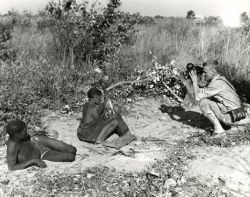Documentary Educational Resources, en conjunto con el Archivo FĂlmico de Estudios Humanos del Smithsonian Institution, se complacen en anunciar que la ColecciĂłn de Cine y Video de John Marshall sobre aborĂgenes australianos 1950-2000, ha sido reconocida por su excepcional valor como parte del Patrimonio Documental de la Humanidad y ha sido incluĂda en la Memoria Registrada del Mundo de la UNESCO.
The John Marshall Ju/'hoan Bushman Film and Video Collection, held at the Smithsonian Institution's Human Studies Film Archives, is one of the seminal visual anthropology projects of the 20th century providing a unique example of sustained audiovisual documentation of one cultural group, the Ju/'hoansi, of the Kalahari Desert in northeastern Namibia, over half a century. It is an unparalleled historical record not only of an indigenous people’s traditional way of life and ties to the land but of the transformation of their life in the rapidly changing political and economic landscape that developed in concert with the struggle for Namibian independence. The collection is only the fourth documentary property held in a United States archive or library to be added to the Memory of the World Register.
Filmmaker John Marshall documented the lives of a group of Ju/'hoansi (!Kung San Bushmen) of the Kalahari Desert in Namibia from 1950-2000. Marshall and his colleagues shot over one million feet of film and, in addition, video (722 hours), beginning in the last years that the Ju/'hoansi still lived by gathering and hunting in their harsh desert environment. Tremendous and rapid changes occurred during the ensuing fifty years, both on the individual level and within Ju/'hoan society at large. Marshall's film and video documents these changes, along with interviews in which Ju/'hoansi share their thoughts and feelings about the past and their hopes and concerns for the future.
All this, as well as audio recordings, photographs, maps, film and videotape logs, translations, and other papers, comprises the John Marshall Ju/’hoan Bushman Film and Video Collection, 1950-2000. This audiovisual collection is unique in the world for its focus on one group of people over such a long period. The materials can be used to study historic and contemporary Ju/'hoan life and culture, as well as the politics of international development, and the cultural landscape of the Kalahari Desert.
More details about the collection can be found in the finding aid: http://www.nmnh.si.edu/naa/fa/marshall.pdf
Marshall's edited films, study guides, etc. are distributed by Documentary Educational Resources: http://www.der.org/films/kung-series.html
UNESCO's press release contains additional information about the Memory of the World Register as well as the full list of inscriptions for 2009: http://portal.unesco.org/en/ev.php-URL_ID=46187&URL_DO=DO_TOPIC&URL_SECTION=201.html
Â
Â









Comments